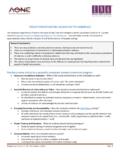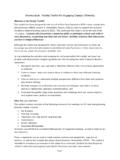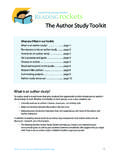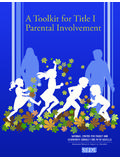Transcription of Community-Led Libraries Toolkit - Working …
1 Starting us all down the path toward developing inclusive public librariesCommunity-Led Libraries Exclusion, Public Libraries , and The Working Together ProjectPreface: Why Working TogetherIntroduction: Community-Led Libraries ToolkitSocial ExclusionWorking Together Sites: OverviewCommunity Engagement in ContextCommunity-Led Service PlanningDeveloping Inclusive Public LibrariesUsing the Tools and AdviceSystemic Barriers to Public Library ServiceCommunity-Led Service Planning ModelThe Tools community Entry community Mapping Relationship Building Partnerships Program Planning Computer Training Collection Development Customer ServiceSupporting the Inclusive Public LibraryPolicy DevelopmentStaff DevelopmentService EvaluationLooking Ahead34710121417182024343551617585951051 111231241301381422almost ready?
2 3 OverviewSocial Exclusion, Public Libraries , and The Working Together ProjectPreface: Why Working TogetherIntroduction: Community-Led Libraries ToolkitSocial ExclusionWorking Together Sites: OverviewCommunity Engagement in lets get started4 Preface:Why Working TogetherBy Brian CampbellFounding Director and former National Director (retired) Working Together ProjectVancouver Public Library (VPL) initiated the Working Together Project in 2004 to develop methods for Libraries to work with low-income communities through a community development approach. Funded as a demonstration project by the Offi ce of Learning Technologies of Human Resources and Social Development Canada, funding was available over three years which was extended to four. The long-term funding was invaluable, allowing the participating Libraries both to undertake the lengthy process of understanding and implementing community development approaches and to incorporate some of their lessons into their library systems.
3 Unfortunately, program and funding constraints centred the Project on urban communities, despite recognition that rural Libraries have similar was such a project necessary?The dominant belief in 2004, as it is today, was that Libraries serve the whole population and are open to all who choose to use it. Indeed, Libraries have instituted many programs to reach out beyond their buildings. Libraries view themselves and are viewed by many users as the living room of the community . They score well in surveys of public services, often ranking just behind the public safety services such as fi re and police. However, other surveys echo library statistics showing that the whole community is not using the library. Usage statistics were particularly troublesome in urban areas with high concentrations of poor, immigrant, and socially excluded individuals.
4 British librarian John Pateman estimated that 40 percent of his community were not library users and 30 percent were marginal on their experience directly serving patrons, library staff at VPL and across Canada expressed concern that Libraries were no longer serving poor and socially excluded people. Many staff pointed to the increasing number of rules, the impact of fi nes, and the focus on information technology as alarming situation is not peculiar to Libraries . A substantial body of literature, including the Royal Commission on Poverty (1968) and literature pre-dating the Commission s report, demonstrates that government offi ces, schools, and hospitals are alien and frightening to many who are socially excluded. Such government institutions public Libraries included primarily serve the middle class, and so are alienating to many then is to be done if we are serious about serving the whole community ?
5 The Libraries in Marginal Communities Demonstration Project started on February 25, 2004 and ended on October 31, 20started on February 25, 2004 and ended on October 31, 2005. The Working Together Project, Working Together Project, which started on November 1, 2005 and is scheduled to end on April 30, 2008, evolves the philosophies and concepts of the fi rst demonstration project. Throughout the Toolkit , these two November 1, 2005 and is scheduled to end on April 30, 2008, evolves the philosophies and concepts of the fi rst demonstration project. Throughout the Toolkit , these two November 1, 2005 and is scheduled to end on April 30, 2008, evolves the philosophies and concepts of the fi rst demonstration project. Throughout the Toolkit , these two related demonstration projects are referred to collectively as the Working Together Project or the Project.
6 Related demonstration projects are referred to collectively as the Working Together Project or the Project. Part I Overview5 The initial Libraries in Marginal Communities Demonstration Project proposal outlined the basic philosophy of the Project: Librarians have important skills and information to share with low-income communities. The community has important knowledge of itself. The eff ort in this project will be to take a community development approach to putting library skills at the service of the community by Working with them to link library services to community understanding of its fi rst phase of the Project placed community Development Librarians (CDLs) in the community to fi nd out what was actually happening and how public Libraries were perceived. While Libraries had made attempts in the past to use a community development approach, with a few exceptions, it has been decades since there was a systematic eff ort across the profession.
7 A signifi cant shock for the CDLs was to discover that many people are critical and even angry at Libraries because of their experiences. Many did not think of the library as a place for them. Their kind was not welcome. This response is verifi ed by the many discussions within Libraries concerning smelly users, inappropriately dressed patrons, and people sleeping in cubicles and with their head on and charges were quickly identifi ed as a barrier for low-income individuals during this fi rst phase. Children are often discouraged from using the library for fear of accruing fi nes. One of the most signifi cant early debates within the Project was whether fi nes should be eliminated, especially for children, and what would be the fi nancial impact on Libraries . Interestingly, the issue of encouraging responsible use became another important debate within the fi rst years of the Project, a debate which often overshadowed the need to encourage socially excluded people to even enter the insights gained in the fi rst phase of the Project resulted in its renaming.
8 First named Libraries in Marginal Communities, the CDLs understood that the name implied a one way relationship and not the mutual and reciprocal relationship our philosophy encouraged. The Project was renamed Working Together: Library community Project also began to understand the gulf that exists between outreach Libraries usual approach to communities and community development, an important distinction that is discussed later in this way6 While there are many specifi c library policies that work against socially excluded individuals, the Project gradually grew to understand that the issues confronting the socially excluded were much larger than individual policies. The culture and environment of the library is also problematic. As a bureaucratic institution, the library develops policies and procedures that simplify and ease the eff orts required to maintain a stable organisation, not the least of which is the comfort and convenience of the staff and administration, as well as the interest of its mainstream socio-economically advantaged is crucial to the success of such an approach.
9 Too often, attempts to reach out to socially excluded non-library users result in token programs or services tangential to the overall service structure of the library. This partition of services exposes such services during the next fi nancial crisis. If the Working Together Project has shown anything, it is that Working with socially excluded people to meet their library needs requires far more than just re-organising existing programs and delivery. Acknowledging that current library models do not work for many socially excluded people necessarily acknowledges the need for more fundamental change. It recognises that change is an ongoing process and that initial attempts, while perhaps partial and modestly eff ective, are still an important beginning. In essence, a single staff position or policy change will not be suffi cient.
10 Transforming staff roles to work with socially excluded communities means changing the way we look at planning, customer service, and policy. It means moving toward a model in which every user is viewed as a complex individual, with history and community , requiring human contact to fully meet their needs. Such a transformation shifts the library back to its human , those excluded by current service approaches extend far beyond those defi ned as socially excluded to include major demographic sectors such as seniors, youth, and children. While the Project s community development approach has been oriented to socially excluded communities, the lessons and approaches are important to radically transform traditional library service for us an ongoing process Part I OverviewPreface7 Introduction: Community-Led Libraries ToolkitBy Sandra SinghNational Director, Working Together ProjectDirector of Systems and Special Projects, Vancouver Public LibraryFour Years of Learning.







